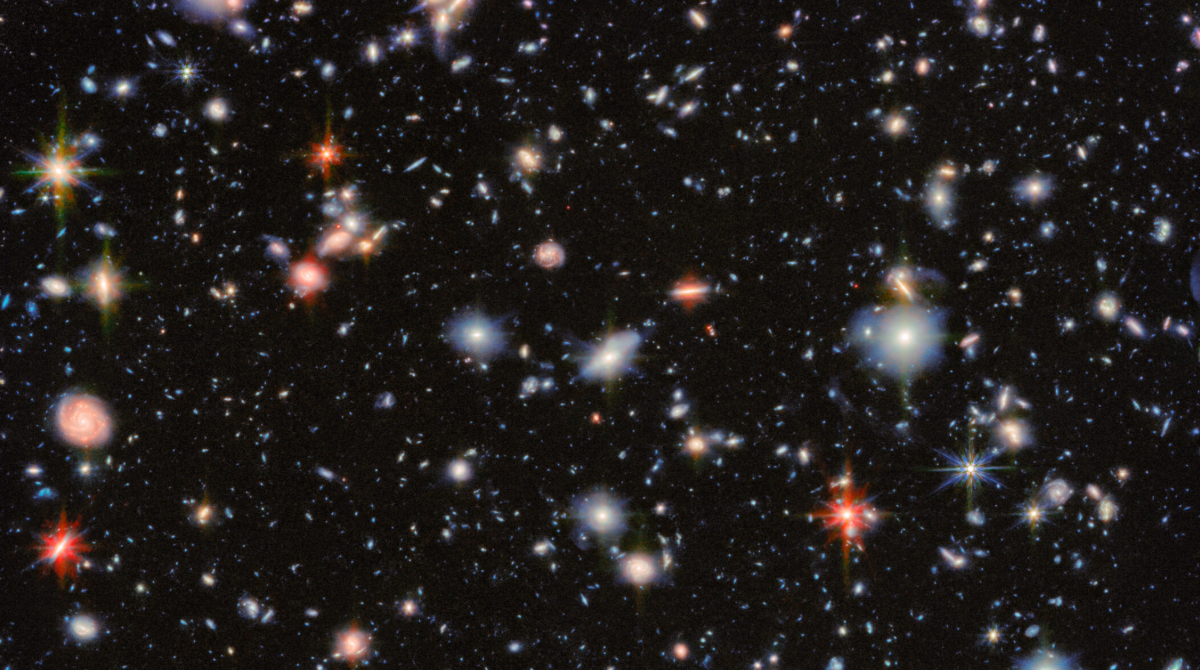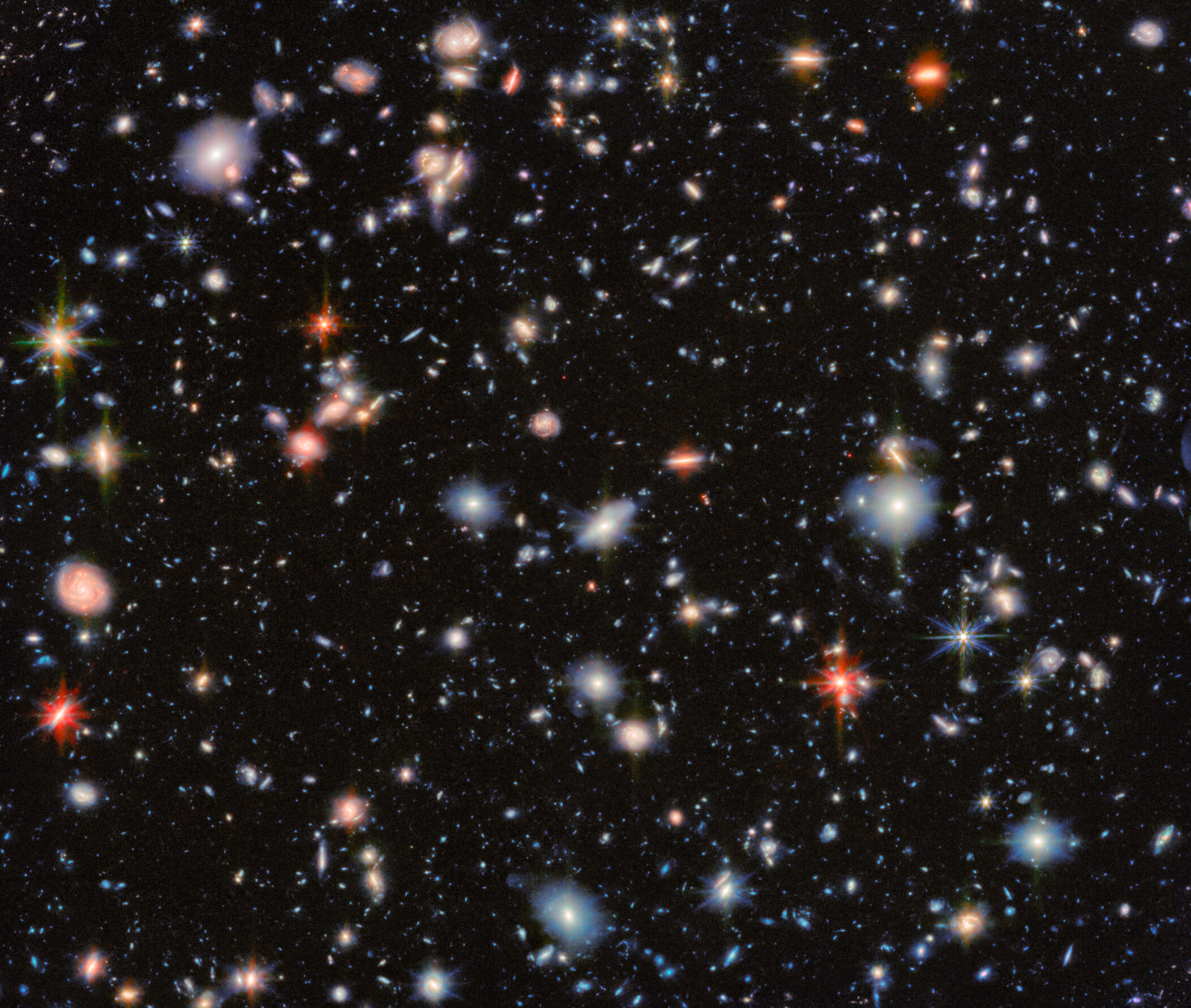James Webb Space Telescope revisits a classic Hubble image of over 2,500 galaxies
The image reveals over 2,500 galaxies, many of which are seen as they were during the first billion years of cosmic history.
The James Webb Space Telescope has returned to the scene of one of the Hubble Space Telescope's most iconic images, the Ultra Deep Field, to capture galaxies throughout cosmic history.
This new image was taken as part of the JWST Advanced Deep Extragalactic Survey (JADES), which is intent on further probing in infrared light two patches of sky that were originally imaged by Hubble: the Hubble Deep Field (1995) and the Hubble Ultra Deep Field (2004).
The deep fields were Hubble's most intense stares into the universe, revealing the faintest galaxies at the highest redshifts that Hubble could see, galaxies that existed over 13 billion years ago and whose light has been traveling for all that time. The Hubble Ultra Deep Field, in particular, was revisited several times by Hubble, in 2009, 2012 and 2014, using the near-infrared channels on the space telescope's Wide Field Camera 3. It shows some 10,000 galaxies detectable in an area of sky just 2.4 arcminutes square, which is less than a tenth of the diameter of the Full Moon in the night sky.

However, Hubble can only see so far. At the greatest redshifts, corresponding to galaxies that we see as they existed within a few hundred million years of the Big Bang, visible light is stretched into infrared wavelengths beyond Hubble's capacity to see. So, to beat this limitation, the JWST has stepped up.
The giant 6.5-meter space telescope got its first good look at the Hubble Ultra Deep Field in October 2022 with its Near-Infrared Camera. It has revisited the Ultra Deep Field several times, as part of the JADES project, and this latest image was captured by the JWST's Mid-Infrared Instrument (MIRI) Deep Imaging Survey (MIDIS for short).
Indeed, the instrument's shortest-wavelength filter (F560W, which detects infrared light from 4.9 to 6.4 microns, centered on 5.6 microns) took the longest exposure of any single filter as part of this image, totaling 41 hours.
The image doesn't show the entirety of the Ultra Deep Field, only a section of it containing about 2,500 visible galaxies, four-fifths of them being truly distant, high redshift galaxies. None are record-breakers — the maximum redshifts visible are about 12, equating to 380 million years after the Big Bang, or 13.4 billion years ago. Just to compare, the current highest redshift galaxy, MoM-z14 (which is not part of the Ultra Deep Field), has a redshift of 14.4 and we see it as it existed about 280 million years after the Big Bang.
Breaking space news, the latest updates on rocket launches, skywatching events and more!
When coupled with data from JWST's Near-Infrared Camera (NIRCam) that operates at shorter wavelengths (1.9 to 4.8 microns), the observations reveal a great deal about the many galaxies in the image, most of which are visible as small dots of light. The image is presented in false color, since infrared light has no visible colors since it is beyond what the human eye can see.

Hundreds of red galaxies in the image are either star-forming galaxies that are shrouded by interstellar dust that absorbs the starlight and re-radiates it in infrared, or are highly evolved galaxies with lots of older, redder stars that formed near the beginning of the universe. Meanwhile, the small greenish-white galaxies are those that are at very high redshift, meaning we see them as they exist mostly during the first billion years of cosmic history. On the other hand, the larger blue and cyan galaxies are closer with low-redshifts and so appear brighter to NIRCam than to MIRI.
Astronomers work to push ever deeper with the JWST, adding observation on top of observations to chart the development of galaxies from close to the dawn of the universe to the present day. Among the data could be answers to many of cosmology's greatest secrets, such as how supermassive black holes formed, how galaxies formed, and when the majority of stars in the universe came into being. This is all still a work in progress, so stay tuned!
A study of the JWST Ultra Deep Field observations as published in the journal Astronomy & Astrophysics.

Keith Cooper is a freelance science journalist and editor in the United Kingdom, and has a degree in physics and astrophysics from the University of Manchester. He's the author of "The Contact Paradox: Challenging Our Assumptions in the Search for Extraterrestrial Intelligence" (Bloomsbury Sigma, 2020) and has written articles on astronomy, space, physics and astrobiology for a multitude of magazines and websites.
You must confirm your public display name before commenting
Please logout and then login again, you will then be prompted to enter your display name.
